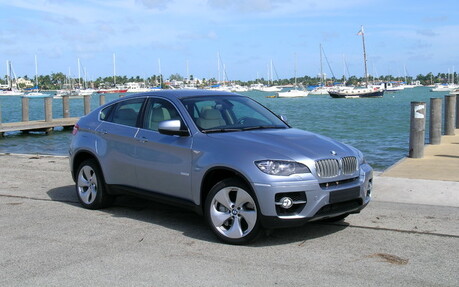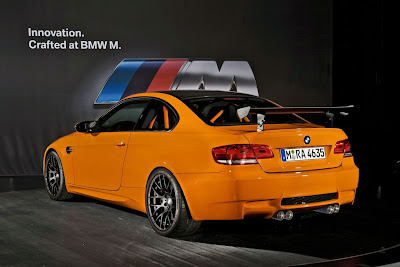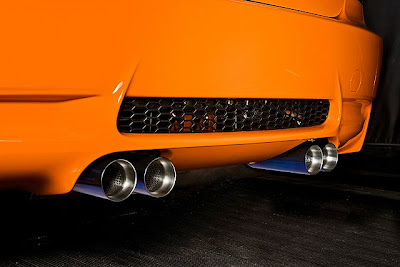
After recently introducing the BMW 7 Series Hybrid, the Bavarian manufacturer is now offering the 2010 BMW X6 ActiveHybrid, its second gasoline- and electric-powered hybrid model. In fact, the X6 will be the first hybrid vehicle sold by BMW since it will arrive here in December, several months before the 7 Series. This is because, like all other models produced at the Spartanburg, North Carolina plant, the X6 ActiveHybrid will be offered on the North American market first, which is not the case for the 7 Series.
Of course, the X6 is a sport SUV and BMW doesn’t intend to try to rival the Toyota Prius: far from it. Rather, the manufacturer wants to offer an engine that performs like a V8 but with fuel consumption similar to that of a V6. I don’t think that having a BMW X6 in with a “Hybrid” logo in your driveway will win you any prizes for environmental activism, but at the very least, it will give the well-to-do a clear conscience and save them from a few disapproving looks.
Hybrid or diesel?Although the manufacturer offered the X5 with a diesel engine, you have to wonder which technology of the future – hybrid, fuel cell or diesel – the manufacturer will ultimately choose. Given the uncertainty, none of the technologies can be put aside so as not to miss the boat. Moreover, according to Jochen Frey, BMW’s director of communications, many technologies will be available in the future and the choice will be a matter of how you plan to use the vehicle. However, since BMW tends to combine diesel with performance, wouldn’t it have made more sense to offer the X6 with a diesel engine and the X5 with a hybrid engine considering the purpose of each? In Europe, the X6 is already offered with a diesel engine which, unfortunately, is not the case here, although it’s a safe bet that an X5 ActiveHybrid is soon to follow. Problem solved...
The BMW X6 ActiveHybrid (its official name) has few differences compared to the conventional versions. With the exception of a few emblems that identify it, its engine type is drawing all the attention. The only version offered is a very well equipped model with the same engine as the X6 50i, a 4.4-litre biturbo featuring 400 horses for a torque of 450 lbs-ft. Throw in a couple of 2.4 KW electric motors for a total power of 480-hp and 575 lbs-ft of torque and you have the most powerful SUV hybrid currently on the market with a 0-100 km/hr time of 5.6 seconds. Not bad for an environmentally-friendly vehicle…
This engine is paired with a seven-speed automatic continuously variable transmission and, as with all versions of the X6, all-wheel drive comes standard. Developed jointly with the now defunct Daimler-Chrysler Corporation, BMW’s technology is similar to Toyota’s in that it allows you to drive in electric mode. In the case of the X6, you can accelerate up to 60 km/hr or drive a distance of about 2.5 kilometres in electric mode but it’s very hard to do without making those following behind impatient. This is a common criticism of all hybrid vehicles. There’s a world of difference between theory and practice.
Sporty linesRight from the start, the BMW X6 won over a lot of people with its unique, sporty lines. You either love it or you don’t. It’s a vehicle that combines the qualities of an SUV with the lines and style of a sport sedan. Thus, the X6 represents the latest mutation of SUVs and this trend is growing with this year’s Acura ZDX. Ironically, SUVs are practically like the flu since there seems to be a new strain every year. It’s hard to find your way when every manufacturer claims to offer a unique, out-of-segment vehicle. The X6 ActiveHybrid stands outs because of the emblems on the body, several exclusive colour schemes and its distinctive Aero rims.
Inside, there are very few changes other than its unique instrument panel that displays information on the hybrid system in blue. The navigation screen also offers a diagram that gives information on one of the four engine modes used. As for the rest, the quality of the passenger compartment, soundproofing and the choice of materials are all excellent. The seats offer good support, but we found them to be very firm on long drives. Just like all the other X6 versions, the vehicle’s style makes rear visibility a challenge.
On the roadAs mentioned previously, the purpose of the X6 ActiveHybrid is not to become the icon of green vehicles for the affluent. BMW wanted to keep all of the X6’s typical features: performance, sport capability and fun, and in this regard they have succeeded. This version offers a very smooth ride, but only if you’re driving exclusively in electric mode. Put the pedal to the metal and the V8 biturbo and electric motor’s combined 575 lbs-ft of torque will pin you to your seat and serenade you with its rich sound. None of its dynamic ride has been sacrificed, although the vehicle is heavier.
As for fuel consumption, this engine demonstrates a 20% improvement over the equivalent model with a gas engine. The numbers announced by BMW, 9.9 litres/100 km, were about what we came up with over the several hundred kilometres travelled during our initial contact. Of course, fuel economy is most noticeable in town since the electric motor is called upon more often. This hybrid version is not the choice for you if you drive exclusively on the highway.
BMW insists that hybrid technology must combine the vehicle’s original qualities with improved fuel economy and reduced emissions. If you agree with this principle, you’ll have to admit that this car gets the job done. However, you have to be prepared to pay the price since, despite some supplementary equipment, the X6 ActiveHybrid comes with a price tag that is almost as hefty as that of the manufacturer’s beastly X6 M.



























